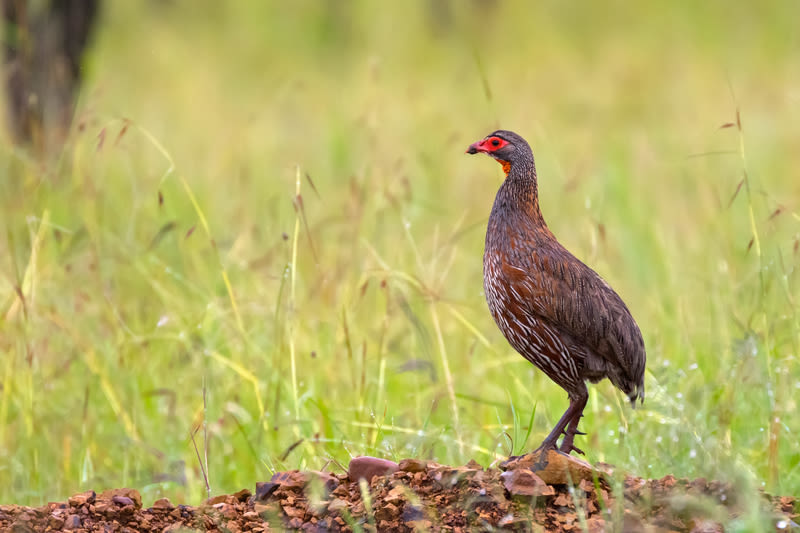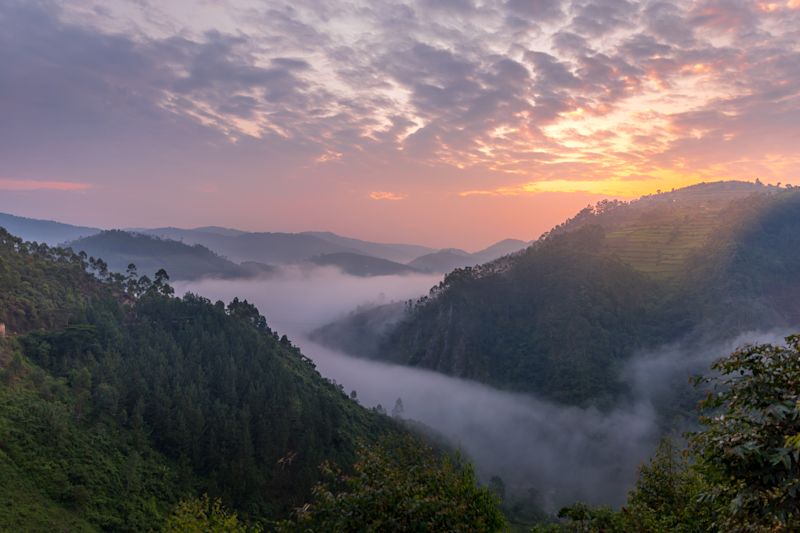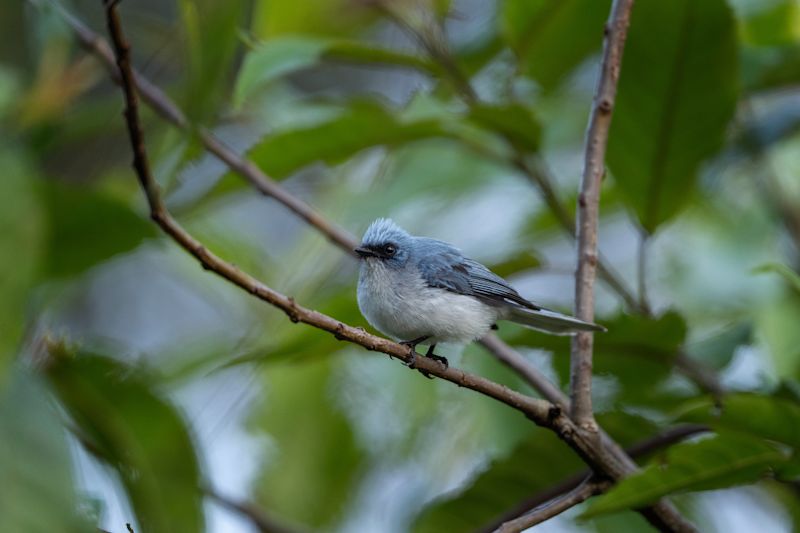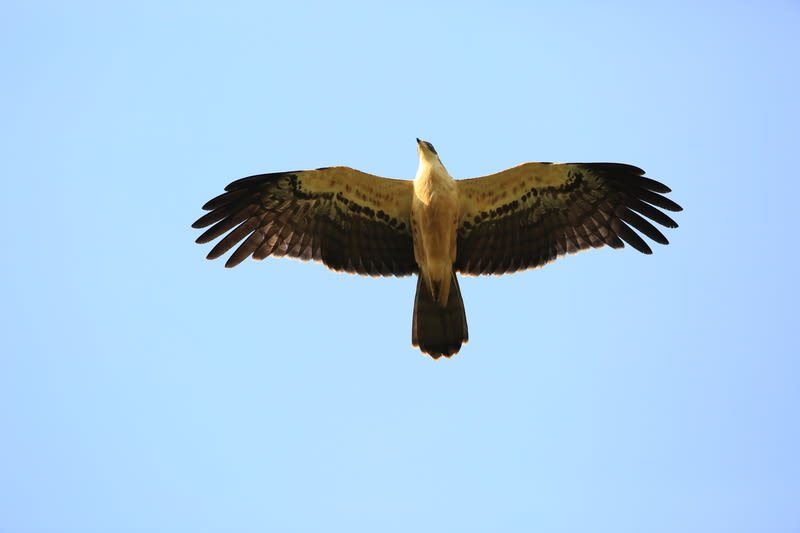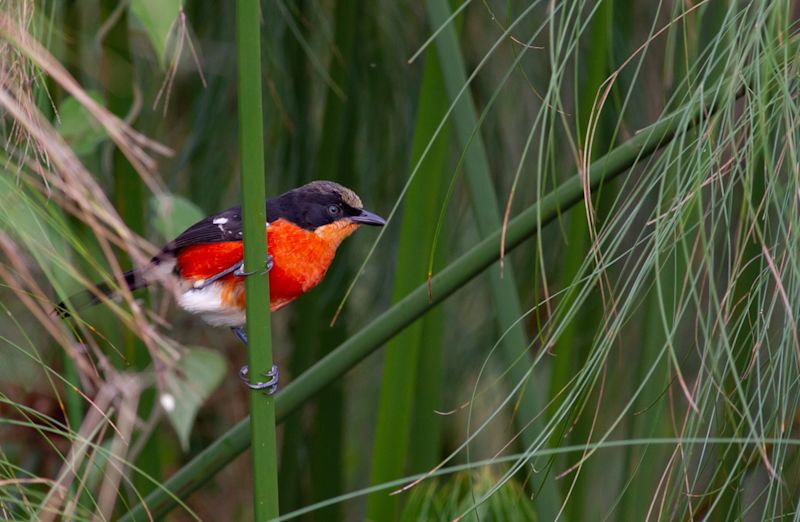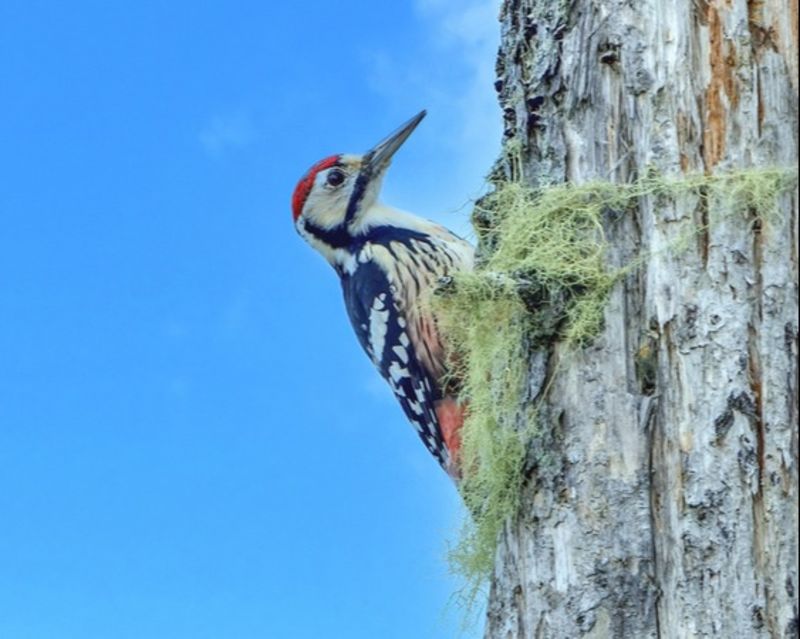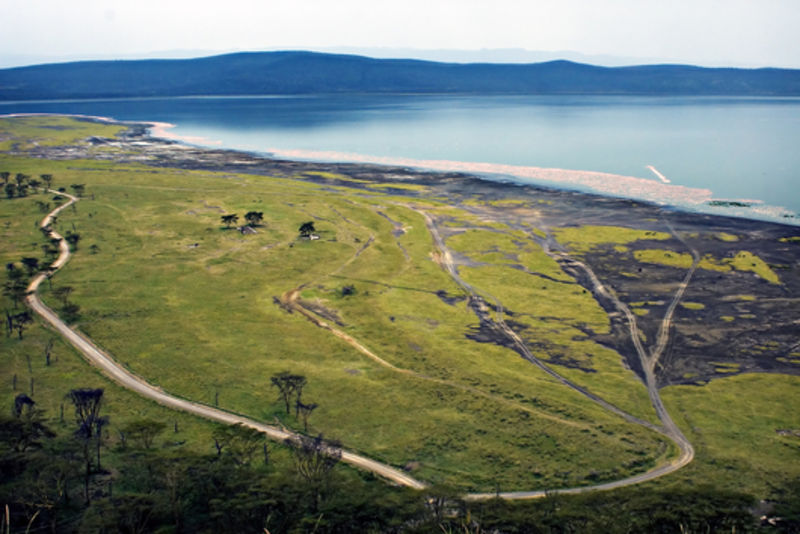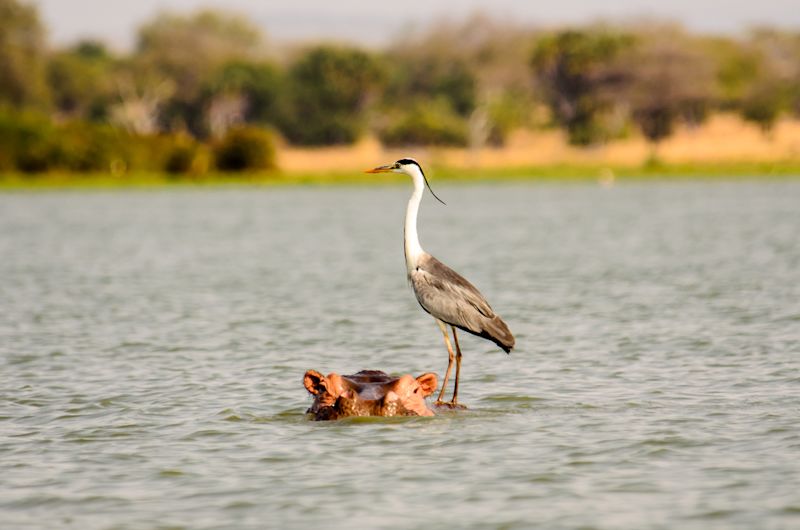When thinking about East Africa's birds, picture shoebills, kori bustards, African fish eagles, pink-backed pelicans, saddle-billed storks, grey crowned cranes, secretary birds, grey-breasted spurfowls, Fox's weavers, cisticolas, yellow-collared lovebirds ... there's just an utterly incredible range of heavenly feathered friends to try to find!
Kori bustards are easy spots throughout East Africa
But does East Africa really stack up, as we're claiming?
Well, in terms of global rankings for number of bird species, you have:
- Tanzania at #12 with 1,074 bird species, of which 31 to 36 are considered endemics.
- Kenya at #13 with 1,058 bird species, of which 10 or 11 are endemics.
- Uganda at #16 with 999 bird species, of which 420 are forest birds.
- Rwanda at #47 with 705 bird species, but remember that this is a tiny country (it's only the size of the Crimea!).
The grey-breasted spurfowl (or francolin) is found only in Tanzania
Right, so where should you visit within each country to have the most exciting birding experiences?
Here are the top nine parks, reserves or regions within these four bird-rich countries that you as a birder should try to visit ...
1. Murchison Falls National Park, Uganda
Murchison Falls National Park in western Uganda has a wide range of ecosystems that allows it to play host to an astonishing 450 bird species. It's also a truly beautiful corner of the world, and so makes it onto our list of The 8 most beautiful national parks in Uganda.
The shoebill stork (or whale head) has become synonymous with Uganda
Of special note for birders are the various waterbirds sustained by the park's waters, which include the Nile River, its delta, and Lake Albert.
Some of the standout birds to look for in Murchison Falls National Park are:
Great blue turaco | Shoebill stork | Puvel's illadopsis |
Red-throated bee-eater | Yellow-footed flycatcher | Giant kingfisher |
Abyssinian ground hornbill | Giant heron | Pennant-winged nightjar |
Marabou stork | Black-headed lapwing | Back-bellied bustard |
Grey crowned cranes are a sublime sight every time with their yellow-gold 'pom-pom'
We list more birds you can see in the park in 10 compelling reasons to visit Murchison Falls National Park. Or for a full list of bird species take a look at Avibase.
Visit Murchison Falls National Park between late May and September if you also want to go on safari while there, as this is when you'll enjoy the driest and mildest weather. That said, migratory birds are present from November to April.
A Fox's weaver, a Ugandan endemic, perched on an acacia branch
Birders are often amazed at the ease with which you can spot and photograph many of Uganda's most illustrious bird species!
2. Bwindi Impenetrable Forest, Uganda
The main thing people think of when they hear Bwindi Impenetrable National Park mentioned is mountain gorilla trekking. That's the cash cow for this important wildlife conservation site. But birders are also in for a treat when they visit this beautiful mountain rainforest in southwest Uganda!
Bwindi Forest is often shrouded in mist
Uganda has 420 forest birds! We don't need to tell you that this is an incredible number, but it's even more impressive when you consider the relatively small size of the country.
Bwindi Impenetrable National Park hosts 350 bird species, of which 14 haven't been recorded anywhere else in the country. It's one of the very best sites for montane birdwatching anywhere in Africa!
An African blue flycatcher on a branch in Bwindi Forest
Here are some of the standout birds to look for in Bwindi Impenetrable Forest:
Bar-tailed trogon | Great blue turaco | Black bee-eater |
Bronze sunbird | Black-and-white shrike-flycatcher | Brown-throated wattle eye |
White-starred robin | African green broadbill | Shelley's crimsonwing |
Oberlaender’s ground-thrush | Dwarf honeyguide | Chapin’s flycatcher |
The north-south road through Bwindi, known as The Neck, is a great one for birders to travel. But there are also many fantastic hiking routes to take you deeper into the jungle.
A great blue turaco in Bwindi Forest
The best time of year to visit Bwindi National Park in general is December to February or June to September, as it's drier at this time. But in terms of birding, you want to visit in May or June for nesting season and abundant sightings, or between October and April for migratory birds.
A black bee-eater
Other notable birding destinations in Uganda
Finally, if you're in Uganda and have more time on your hands, other notable destinations offering incredible birding opportunities are:
- Semuliki National Park, which protects East Africa's only lowland tropical rainforest.
- Budongo Central Forest Reserve, a tropical rainforest in the Albertine Rift Valley.
- Queen Elizabeth National Park, which is a very popular game-spotting park too.
- Mgahinga National Park, where you can also go gorilla trekking.
- Kibale Forest National Park, a great place to also go chimpanzee trekking.
- Lake Mburo National Park, which boasts about 350 bird species.
- Entebbe Mbamba Swamp, the ideal location to see shoebills.
Cinnamon-chested bee-eaters can be found throughout East Africa
3. Nyungwe Forest National Park, Rwanda
Nyungwe Forest National Park is located in southern Rwanda in the Albertine Rift (the western branch of the East African Rift, also known as the Great Rift Valley).
An Ayres's hawk-eagle seen flying over Nyungwe Forest National Park
Nyungwe Forest is an amazing place to visit for various reasons, including that it has 248 species of orchids and 13 species of primates (including chimpanzees). But more importantly to our purposes here, it's one of the very best East African destinations for birders, hosting an incredible 29 Albertine Rift endemics.
Nyungwe Forest is home to 300 bird species, with 29 of them being Rift Valley endemics! So this is an absolute jewel of a site for birders.
The 70 metre-high canopy walkway in Nyungwe is perfect for birdwatching
Some of the Albertine Valley endemic bird species to look for in Nyungwe Forest are:
Stripe-breasted tit | Ruwenzori nightjar | Archer's robin-chat |
Blue-headed sunbird | Buff-throated apalis | Regal sunbird |
Strange weaver | Yellow-eyed black flycatcher | Red-collared babbler |
Purple-breasted sunbird | Red-faced woodland warbler | Red-throated alethe |
There are also over 200 species of trees to enjoy in the park
Of especial note to visitors in the park are:
- Kamiranzovu Swamp, a high-altitude marshland with a beautiful waterfall, gorgeous foxglove orchids and two endemic bird species (Grauer's Rush Warbler and the Albertine owlet).
- The kilometre-long canopy walkway, which is the third longest in Africa and offers an excellent vantage point for birders.
- Colobus monkey or chimpanzee treks, where you go on a guided hike in the forest to find primates, but also invariably spot many beautiful and rare birds!
- The 13 different hiking routes, which range from one to eight hours in duration, let you take things at your own pace and look for birds to your heart's content.
A Ruwenzori batis (an endemic) spotted in Nyungwe Forest National Park
Most of the park's bird species are residents, so you can visit throughout the year and have a great birding adventure. July to September is the dry season, and many birds nest at this time. Migratory birds can be spotted between November and April.
The very best birding months in Nyungwe Forest are December, January and February as migratory birds are present and it's not too wet.
A strange weaver spotted in Nyungwe Forest
4. Akagera National Park, Rwanda
Akagera National Park in eastern Rwanda is well-known as a traditional safari destination as it has a fantastic big game population, including all of the Big Five. The land consists of savannah, hills, woodlands, lakes and wetland.
An African fish eagle spotted in Akagera National Park
Akagera National Park is the most diverse bird habitat in Rwanda, with over 480 recorded bird species.
A papyrus gonolek in the Akagera Wetland
Given all of the game that thrives in Akagera National Park, you can look forward to seeing many raptors when you visit (there are 44 raptor species). There are also plenty of waterbirds, as the park has many lakes and a wetland. A great way to see many of the species is to go on a boat cruise on Lake Ihema, the park's biggest lake.
The white-headed vulture is critically endangered
Some of the notable birds to look for when visiting Akagera National Park are:
White-headed vulture | Griffon vulture | African harrier hawk |
Shoebill stork | African openbill | Grey hornbill |
Fan-tailed widow bird | Black-headed gonolek | Northern brown-throated weaver |
White-winged swamp warbler | White-collared oliveback | Carruthers’s cisticola |
A great spotted woodpecker sighted in Akagera
Other notable birding destinations in Rwanda
If you have more time in Rwanda, some other incredible birding destinations are:
- Volcanoes National Park, a beautiful protected area of montane rainforest famous for its mountain gorilla treks.
- Rugezi Marsh, a wetland near the headwaters of the Nile with 43 resident bird species.
- Lake Kivu, where you can go on lovely lakeshore hikes or boat cruises to spot many of the area's 750 bird species.
- Gishwati Mukura Forest National Park, which hosts 20 endemic bird species as well as 10 species on the IUCN Red List.
The white-eyed slaty flycatcher lives in the highlands of East Africa
5. Lake Nakuru National Park, Kenya
Lake Nakuru National Park is just heaven for waterbird sightings. A particular drawcard is the millions of flamingoes that can stain the waterline pink. The backdrop to the lake is also sublime, as it's located on the floor of the Great Rift Valley.
A stretch of pink is created along the shoreline of Nakuru by its flamingoes
Lake Nakuru in central Kenya sometimes hosts around 1.5 million lesser flamingoes and 9,000 greater flamingoes!
Lesser flamingoes turn pink because of the algae they eat
Some of the other standout birds to look for in Lake Nakuru National Park are:
Red-knobbed coot | Blackmith lapwing | Sacred ibis |
African fish eagle | Hemprich's hornbill | Jackson's hornbill |
Kittlitz’s plover | Great white pelican | White-backed vulture |
Rüppell's griffon vulture | Black-tailed godwit | Great snipe |
A marabou stork and black-headed ibis on Lake Nakuru
Note that many millions of lesser and greater flamingoes flock to the various alkaline Great Rift Valley lakes in Kenya and Tanzania, so you could replace a Lake Nakuru visit with one of them and have an equally awesome adventure. We're talking here of Lakes Naivasha, Bogoria and Baringo in Kenya and Lakes Natron and Manyara in Tanzania.
Lesser flamingos on Lake Bogoria
6. Arabuko Sokoke Forest Reserve, Kenya
Arabuko Sokoke Forest can be found just inland from the central eastern coastline of Kenya. This important coastal forest (the largest in East Africa) protects four endangered mammals as well as six threatened bird species. Overall, 600 bird species have been spotted here, and there's a high level of endemism.
A pair of Sokoke scops owls spotted in Arabuko Sokoke Forest
Here are some of the standout birds to look for in Arabuko Sokoke Forest:
Sokoke pipit | Clarke's weaver | Amani sunbird |
Little-yellow flycatcher | Spotted ground thrush | Terek sandpiper |
Crab plover | East coast akalat | Northern carmine bee-eater |
Southern-banded snake eagle | Fisher’s turaco | Plain-backed sunbird |
African paradise flycatcher and ashy flycatcher in Arabuko Sokoke Forest
Birders should visit Kenya between November and April as this is when migrant birds come to the Rift Valley and coastline. If you want to combine your birding holiday with a safari or beach holiday, you might like to read Best time to visit Kenya for safaris, beach holidays and diving.
Clarke's weaver is endemic to Kenya
Other notable birding destinations in Kenya
Avid birders should also consider visiting these parks and reserves while in Kenya:
- Samburu National Park in north-central Kenya which has blue-necked ostriches.
- Tsavo East National Park in south Kenya which has more than 500 bird species!
- Maasai Mara National Reserve, which is especially good for raptor sightings.
- Mount Kenya National Park, which boasts six mountain endemic bird species.
- Aberdare National Park, whose forests and moorlands host 290 bird species.
A blue-necked (or Somali) ostrich in north Kenya
Kenya claims the third spot globally for a Big Day (number of bird species spotted in a single day)!
7. Selous Game Reserve, Tanzania
A grey heron hitching a ride on a hippo in Selous!
Selous Game Reserve in central Tanzania is a UNESCO World Heritage Site, the second largest wildlife sanctuary in Africa, the undisputed jewel in the crown of Tanzania's Southern Safari Circuit, and an utterly gorgeous spot on the globe. And on top of all this, more than 450 bird species have been recorded here!
A Pel's fishing owl
The Rufigi River is the soul of Selous, and it has created or sustains a wide range of beautiful habitats that attracts all sorts of birds. We're talking riverine forest, a network of lagoons, islets, swamps, groundwater forest, woodlands, and more.
A brown-hooded kingfisher in Selous
Some of the standout bird species to look for in Selous Game Reserve are:
African wattled lapwing | African spoonbill | Pearl-spotted owlet |
White-headed lapwing | African skimmer | Böhm’s bee-eater |
Yellow-billed stork | Palm-nut vulture | Rock pratincole |
Racket-tailed roller | Dickinson’s kestrel | White-backed night heron |
You can go on guided bush walks or safari drives to look for wildlife and birds.
A white-fronted bee-eater in Selous
For migratory birds and nesting residents, visit Selous National Park between November and April.
8. Tarangire National Park, Tanzania
Tarangire National Park forms part of Tanzania's famous Northern Safari Circuit. This savannah park is famous for its big game (especially its large elephant herds), enormous baobab trees, and massive red termite mounds. It also has over 550 bird species!
Elephants shelter from the heat under a baobab tree in Tarangire
Tarangire National Park boasts more breeding bird species than anywhere else on Earth! It's birding heaven.
Lilac-breasted rollers abound within Tarangire
Visitors to the park will enjoy game-spotting along with their birdspotting, as you must stay in your 4x4 while in the park given there are lions and other predators about. That said, you can get out and enjoy a stretch and some birdspotting at the picnic spot above the river.
An endemic ashy starling on a termite mound
Some of the many standout bird species to try find while in Tarangire are:
Masai ostrich | Eastern crested guineafowl | Maccoa duck |
Denham's bustard | Kori bustard | Black-tailed godwit |
African woolly-necked stork | Lappet-faced vulture | Rüppell's griffon |
Martial eagle | Nubian woodpecker | Yellow-collared lovebird |
Red and yellow barbets can often be spotted on the park's termite mounds
The best months in Tarangire National Park for birding are October to May, as this is when winter migrants are present in the park. But go earlier rather than later, as the park's swampland can become impassable from late March.
A Von der Decken's hornbill spotted in Tarangire
If you'd like to know more about this fantastic game reserve, please read The incredible wildlife of Tarangire National Park.
9. Ngorongoro Crater, Tanzania
Ngorongoro Crater, arguably the world's eighth natural wonder, is home to over 550 bird species! That's a truly staggering number given this one crater (or, more accurately, caldera) is just 264 km².
For comparison, Tarangire National Park (which has the same number of bird species as Ngorongoro Crater) is 2,850 km² – that's 10 times the size of Ngorongoro Crater. 😱
Two common ostriches in Ngorongoro Crater
You cannot walk inside Ngorongoro Crater, although you can do hikes in the tangled rainforest that covers its rim. To drop down into the crater bowl, you must go with a tour guide in a safari vehicle.
There are various habitats to explore once down there, including lakes, wetland and woodland. Sightings of many large birds and waterbirds are a guarantee!
Two dark-capped bulbuls spotted in the crater
Some of the exciting bird species (both easy and hard to spot) to look for in Ngorongoro Crater are:
Secretary bird | Lesser flamingo | Saddle-billed stork |
Kori bustard | Jackson's Turaco | Hildebrandt's spurfowl |
Rufous winged sunbird | Usambara weaver | Rufous-tailed weaver |
Crested francolin | Purple-crested turaco | Pink-backed pelican |
Ngorongoro Crater is utterly chockfull of wildlife
A real drawcard of Ngorongoro Crater is that it allows you to see many rare, beautiful, migrant and endemic birds in a short space of time.
A hamerkop found in the crater
If you’re keen to see the migrant bird species that visit the crater, then plan your trip between September and April.
Finally, if you'd like to know more about the crater and its mind-boggling array of wildlife, as well as other bird species that can be found here, please read 12 great facts about Tanzania's Ngorongoro Crater.
A black kite seen in Ngorongoro Crater
Other notable birding destinations in Tanzania
- Jozani Forest–Chwaka Bay National Park in Zanzibar, which boasts over 60 bird species, including many waders.
- Lake Manyara National Park, whose lake is often covered in flamingoes, pelicans and other waterbirds.
- Arusha National Park, which is within sight of Mt Kilimanjaro and attracts many species with its beautiful Momela Lakes.
- Serengeti National Park, where you can also witness the incredible Great Wildlife Migration.
A Zanzibar red bishop
So, are you as excited as ever to go birdspotting in East Africa? If not, there's no way you're actually a birder!



